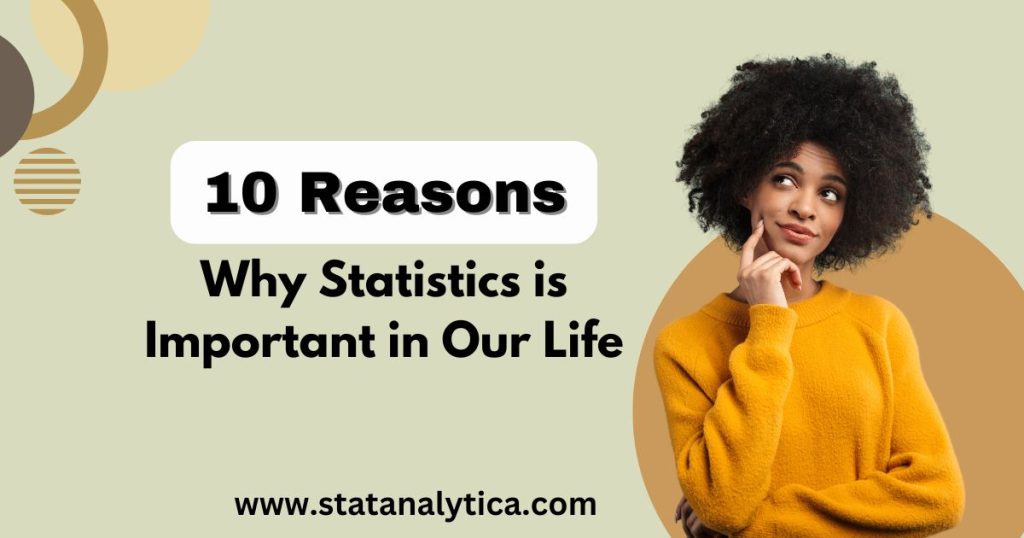Today, statistics is an essential part of society, serving as a basis of individual and collective decision-making processes, as well as the shaping of public policies. Despite the fact it may be viewed as something numerical and far from us, the idea of statistics is crucial for many aspects of human lives. In all aspects of life, big and small, simple and complex, statistics provide understandings that guide decisions as small as attempting a new medical treatment or as huge as investing money. In this blog, we discuss the 10 reasons why statistics is important in our life.
1. Informed Decision-Making
Table of Contents
Statistics enables us to reduce the degree of risk and uncertainty by providing a set of figures that give a better perspective. At the individual level, statistical information can help make decisions concerning finance, learning, and occupation. On a large scale, businesses apply statistics as tools to enhance strategies, forecast events and manage resources well.
To explain this, let me use an example of a company that has developed a new product. Market trend analysis, as well as customers’ and competitors’ data and research that estimates their present and future growth, can be useful in formulating the most effective and profitable approach. Statistics transform raw data into usable information so that people can make accurate decisions in every aspect of life.
2. Heath and Medical Improvements
There are applications in healthcare, not excluding the fact that, in order to advance, statistics is a necessity owing to the fact that by means of it, doctors, researchers, and policymakers can discover and investigate fundamental patterns. Clinical trials are based on statistical tools to determine the efficiency and efficacy of new therapies.
This way, the researchers can identify which of the therapies produce good results and which must be tweaked. In the instance of an outbreak like COVID-19, statistical models were used to monitor the rate of infections, calculate the escalation of healthcare requirements and ration the vaccines. Statistics not only back up clinical advancement but also directly contribute to patient care and the status of the population as a whole.
3. Business and Economic Prediction
In the financial business arena, statistics play an important role in determining the present and coming future economies. Sales information, including patterns in the market and customer tastes, are used by business management to determine such factors as prices, stocks, and promotional campaigns. It helps the businesses understand future economic conditions and also evaluate the performance level to overcome competitors and make the right financial decisions.
For example, a retail selling firm may analyze consumer purchasing trends during a particular season to develop a strategic way of restocking products to avoid having several unsold products. As a result, be it small and medium enterprises or large global firms, statistical tools are essential for adapting to the fluctuations of the economy.
4. Education and Academic work
Statistics becomes a prerequisite tool in the formulation of learning outcomes and policies here. Teachers and policymakers employ statistical information to measure students’ productivity, determine the efficiency of teaching material, and eliminate or reduce inequalities in learning. Achievement tests, questionnaires, and researcher-made tests involving statistical analysis predict students’ comprehension and enhance teaching techniques.
Only by knowing these data points can educational institutions make appropriate changes so that students will have the best chances for success. Moreover, in scholarly research, statistics is critical for affirming conclusions making certain that they are accurate, repeatable, and practical.
5. Quality Control in Manufacturing.
In manufacturing, statistics helps in maintaining quality of products produced and its compliance with specific customer’s expectations. Another statistical technique is Six Sigma based on control charts to analyze data that interested parties use to assess production processes, thus reducing variation.
For instance, an automobile firm will employ statistical sampling to check vehicles for faults or vices to guarantee safety. In enhancing the reduction of variation and consecutively enhancing the methods of completion, statistics assist manufacturers in delivering quality products without wasting a lot of time, thus satisfying customers. All this puts an emphasis on quality control, which in retrospect helps fortify a company’s image and improve the consumer trust.
6. Environmental and Climate Studies
They remain central to environmental science as they supply information about the changes in the environment and the more intricate aspects of the climate system. Environmentalists apply statistical measures to analyze levels of pollution, rate the existence of species, and appraise the successes of environmental conservation. Policies depending on climate understanding are associated with temperature forecasts, concentration of CO2, and aspects of rainfall.
For instance, the quantitative evaluation of global warming allows researchers to help people understand why it is time to pursue the policy of environmental conservation.
7. Sports Performance and Analytics
In the sphere of sports statistics is the driver of both player performance and strategy of coaches as well as fans. Individual worker statistics are also used by the teams in charge of structuring training programs so as to identify some workers’ strengths and areas of weakness and to come up with strategies to win certain games. Readily, statistical analysis also helps coaches make decisions on ‘the fields’ during games, hence enhancing the probability of the team’s success.
Data consumption by fans has also changed because fans are now able to follow analyses based on statistics such as player performances, predictions of the outcomes of games, and overall historical data.
8. Policy-Making and Governance
Through census data, policies that will help solve social, economic, and even environmental challenges are developed by the governments. For example, it is quite hard to contemplate the portion of each population to allocate resources, the layout of towns and cities or the provisions of social services without accurate data from the census. Similarly, crime figures are used in policy formation and operations within law enforcement and public security sectors. At the same time, other aspects of data apply to monetary and fiscal policies in the economy.
This way, decision-making based on statistical data provides evidence of the needs that citizens have and the fair distribution of scarce resources; as we have seen, present day governance relies heavily on statistics, therefore core to creating sustainable and adaptable societies.
9. Risk Management and Insurance
Indeed, in the insurance business, actuarial science as the study of risks and forecasts, is central to the determination of the premiums to be charged. Insurers utilize statistical analyses to predict the risks such as accidents, disease, and other catastrophes, for actuaries to assess the insuring rates.
From the insurance data generated in this study, companies can design policies to match specific risks, thus being financially sound while fulfilling clients’ needs. For instance, the rates of the life insurance policies depend on the statistical information of life expectance, health and other life activities. This actuarial approach proves apparent insurance protection in conjunction with the cost of such protection to both the insurer and the policyholder.
10. Personal Finance and Budgeting
In other words, simple statistical skills can be of great help to an individual with personal financial management. This is evident in that by assessing the amount of money spent and the income earned, people are able to come up with a list of the amount of money that should be spent and earned in a given period, thus developing a budget, setting worthy financial goals and goals and good investment decisions. The concept of statistics can also be applied to issues to do with control of debts, saving for the future and even retirement.
For instance, knowledge of compound interest rates and inflationary tendencies enables people to achieve these and perform long-term conservation. Thus, the use of statistics as a regulatory tool means consistent control over the financial situation, which in turn affects the effectiveness of the management process by providing the subject with enough objective information about his financial state to help him become more active.
Conclusion
Statistical methods signify a science that is much wider than academic classes or complicated equations. It has become a thread that runs through every aspect of our lives, cutting across the purchases we make and the procedures we implement, including the manner in which we filter and make sense of our surroundings. One can only imagine that as technology develops and information becomes more accessible, the role of the statistician will increase.
With this knowledge, the use of statistics in decision-making is reasonable. There is an improvement in the quality of life within society, and number systems are more fulfilling. In any field, from economics to medicine, education or individual finance, statistics provides the means to translate raw data into usable information so that we make better decisions and live our lives to the fullest.


